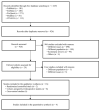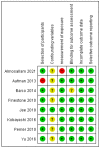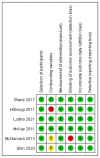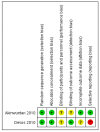Driving Rehabilitation for Stroke Patients: A Systematic Review with Meta-Analysis
- PMID: 37297777
- PMCID: PMC10252792
- DOI: 10.3390/healthcare11111637
Driving Rehabilitation for Stroke Patients: A Systematic Review with Meta-Analysis
Abstract
Driving enables stroke survivors to freely participate in social integration. The purpose of this review was to summarize the evidence for the therapeutic effects of driving rehabilitation for patients when they return to driving after stroke and evaluate the predictors of returning to driving to identify the factors impacting their driving rehabilitation. This study employed a systematic review and meta-analysis. PubMed and four other databases were searched until 31 December 2022. Our review included randomized controlled trials (RCT) and non-RCTs that investigated driving rehabilitation for stroke and observational studies. A total of 16 studies (two non-RCT and 14 non-RCT) were reviewed; two RCTs investigated the effect of driving rehabilitation with a simulator system, and eight and six non-RCTS evaluated the predictive factors of driving return post-stroke and compared the effects of driving rehabilitation for stroke, respectively. The National Institute of Health Stroke Scale (NIHSS) and Mini Mental State Examination (MMSE) scores and having paid employment were significant predictors of resuming driving after stroke. The results suggest that NIHSS, MMSE, and paid employment are predictors of returning to driving post-stroke. Future research should investigate the effect of driving rehabilitation on the resumption of driving in patients with stroke.
Keywords: automobile driving; predictors; rehabilitation; stroke.
Conflict of interest statement
The authors declare no conflict of interest.
Figures






Similar articles
-
Association of Age and Neurological Severity at Intensive Care Unit Admission With Driving Resumption Within 30 Days of Stroke: A Single-Center Historical Cohort Study.Cureus. 2024 Sep 6;16(9):e68800. doi: 10.7759/cureus.68800. eCollection 2024 Sep. Cureus. 2024. PMID: 39246635 Free PMC article.
-
Systematic reviews of the effectiveness of day care for people with severe mental disorders: (1) acute day hospital versus admission; (2) vocational rehabilitation; (3) day hospital versus outpatient care.Health Technol Assess. 2001;5(21):1-75. doi: 10.3310/hta5210. Health Technol Assess. 2001. PMID: 11532238 Review.
-
Support for stroke patients in resumption of driving: patient survey and driving simulator trial.Int J Gen Med. 2011 Mar 3;4:191-5. doi: 10.2147/IJGM.S17475. Int J Gen Med. 2011. PMID: 21475633 Free PMC article.
-
Effects of moxibustion on cognition and activities of daily living in post-stroke cognitive impairment: A systematic review and meta-analysis of randomized controlled trials.J Nurs Scholarsh. 2023 Mar;55(2):464-476. doi: 10.1111/jnu.12846. Epub 2022 Nov 8. J Nurs Scholarsh. 2023. PMID: 36345735
-
Predictors of return to driving after stroke.Am J Phys Med Rehabil. 2013 Jul;92(7):627-34. doi: 10.1097/PHM.0b013e318282bc0d. Am J Phys Med Rehabil. 2013. PMID: 23370577 Free PMC article.
Cited by
-
Neural Plasticity Changes Induced by Motor Robotic Rehabilitation in Stroke Patients: The Contribution of Functional Neuroimaging.Bioengineering (Basel). 2023 Aug 21;10(8):990. doi: 10.3390/bioengineering10080990. Bioengineering (Basel). 2023. PMID: 37627875 Free PMC article. Review.
-
Bibliometric and visualized analysis of the application of artificial intelligence in stroke.Front Neurosci. 2024 Sep 11;18:1411538. doi: 10.3389/fnins.2024.1411538. eCollection 2024. Front Neurosci. 2024. PMID: 39323917 Free PMC article.
References
Publication types
LinkOut - more resources
Full Text Sources

